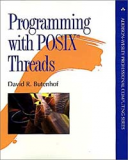Книга: Programming with POSIX® Threads
8.2.2 Use the right number of mutexes
The first step in making a library thread-safe may be to create a "big mutex" that protects all entries into the library. If only one thread can execute within the library at a time, then most functions will be thread-safe. At least, no static data will be corrupted. If the library has no persistent state that needs to remain consistent across a series of calls, the big mutex may seem to be enough. Many libraries are left in this state. The standard X11 client library (Xlib) provides limited support for this big mutex approach to thread-safety, and has for years.
But thread-safety isn't enough anymore — now you want the library to perform well with threads. In most cases, that will require redesigning the library so that multiple threads can use it at the same time. The big mutex serializes all operations in the library, so you are getting no concurrency or parallelization within the library. If use of that library is the primary function of your threads, the program would run faster with a single thread and no synchronization. That big mutex in Xlib, remember, keeps all other threads from using any Xlib function until the first thread has received its response from the server, and that might take quite a while.
Map out your library functions, and determine what operations can reasonably run in parallel. A common strategy is to create a separate mutex for each data structure, and use those mutexes to serialize access to the shared data, rather than using the "big mutex" to serialize access to the library.
With a profiler that supports threads, you can determine that you have too much mutex activity, by looking for hot spots within calls to pthread_mutex_ lock, pthread_mutex_unlock, and pthread_mutex_trylock. However, this data will not be conclusive, and it may be very difficult to determine whether the high activity is due to too much mutex contention or too much locking without contention. You need more specific information on mutex contention and that requires special tools. Some thread development systems provide detailed visual tracing information that shows synchronization costs. Others provide "metering" information on individual mutexes to tell how many times the mutex was locked, and how often threads found the mutex already locked.
- Sequence number
- 4.4.4 The Dispatcher
- About the author
- Conventions used in this document
- Chapter 7. The state machine
- Chapter 15. Graphical User Interfaces for Iptables
- Appendix E. Other resources and links
- Terms used in this document
- What NAT is used for and basic terms and expressions
- Example NAT machine in theory
- Раздел uses
- The final stage of our NAT machine




